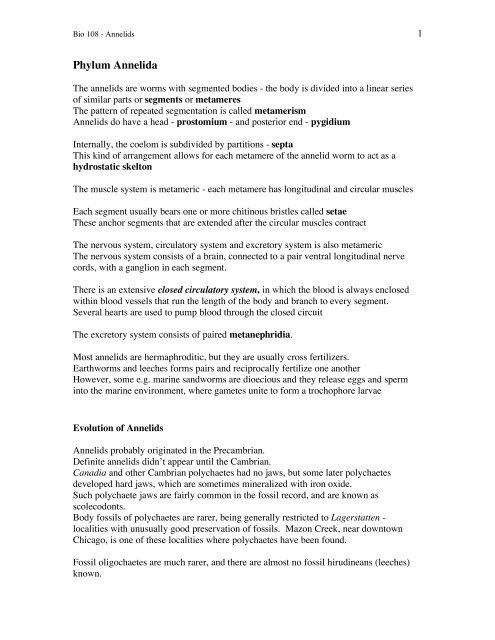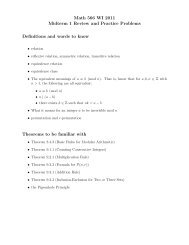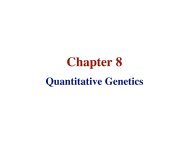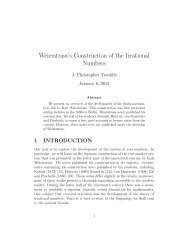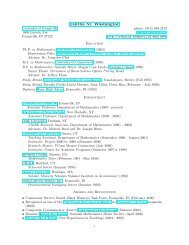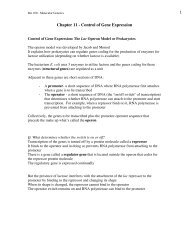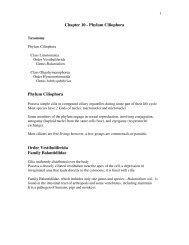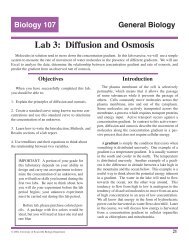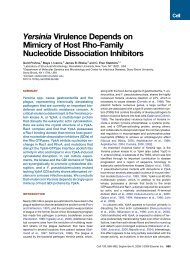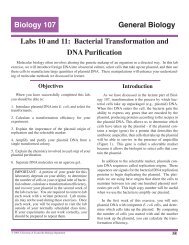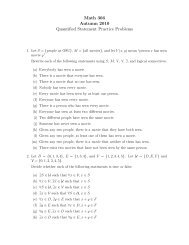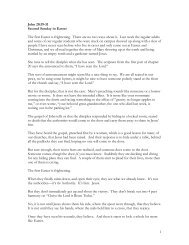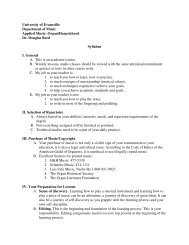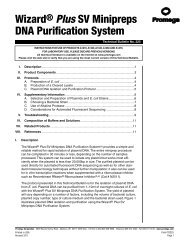Phylum Annelida
Phylum Annelida
Phylum Annelida
Create successful ePaper yourself
Turn your PDF publications into a flip-book with our unique Google optimized e-Paper software.
Bio 108 - Annelids 1<br />
<strong>Phylum</strong> <strong>Annelida</strong><br />
The annelids are worms with segmented bodies - the body is divided into a linear series<br />
of similar parts or segments or metameres<br />
The pattern of repeated segmentation is called metamerism<br />
Annelids do have a head - prostomium - and posterior end - pygidium<br />
Internally, the coelom is subdivided by partitions - septa<br />
This kind of arrangement allows for each metamere of the annelid worm to act as a<br />
hydrostatic skelton<br />
The muscle system is metameric - each metamere has longitudinal and circular muscles<br />
Each segment usually bears one or more chitinous bristles called setae<br />
These anchor segments that are extended after the circular muscles contract<br />
The nervous system, circulatory system and excretory system is also metameric<br />
The nervous system consists of a brain, connected to a pair ventral longitudinal nerve<br />
cords, with a ganglion in each segment.<br />
There is an extensive closed circulatory system, in which the blood is always enclosed<br />
within blood vessels that run the length of the body and branch to every segment.<br />
Several hearts are used to pump blood through the closed circuit<br />
The excretory system consists of paired metanephridia.<br />
Most annelids are hermaphroditic, but they are usually cross fertilizers.<br />
Earthworms and leeches forms pairs and reciprocally fertilize one another<br />
However, some e.g. marine sandworms are dioecious and they release eggs and sperm<br />
into the marine environment, where gametes unite to form a trochophore larvae<br />
Evolution of Annelids<br />
Annelids probably originated in the Precambrian.<br />
Definite annelids didn’t appear until the Cambrian.<br />
Canadia and other Cambrian polychaetes had no jaws, but some later polychaetes<br />
developed hard jaws, which are sometimes mineralized with iron oxide.<br />
Such polychaete jaws are fairly common in the fossil record, and are known as<br />
scolecodonts.<br />
Body fossils of polychaetes are rarer, being generally restricted to Lagerstatten -<br />
localities with unusually good preservation of fossils. Mazon Creek, near downtown<br />
Chicago, is one of these localities where polychaetes have been found.<br />
Fossil oligochaetes are much rarer, and there are almost no fossil hirudineans (leeches)<br />
known.
Bio 108 - Annelids 2<br />
Annelid Diversity<br />
Class Polychaeta ("many bristled")<br />
Each segment is equipped with a pair of fleshy paddle-like structures - parapodia<br />
And the parapodia contain a large number of chitinous bristles - setae<br />
The head or prostomium usually is well equipped with sensory structures<br />
The mouth is located just below the prostomium, but in front of the modified segments<br />
collectively called the - peristomium<br />
The digestive system includes a muscular pharynx that can be everted through the mouth<br />
The pharynx is equipped with pincer like jaws for prey capture<br />
Smaller polychaetes lack respiratory structures; larger ones possess gills<br />
Gills are usually modifications of the parapodia<br />
Some polychaetes are sedentary and burrow into mud or live in protective tubes in the<br />
mud<br />
And in several of these species filter feeding has evolved<br />
e.g., the fan worm (Sabella) with their feather-like head structures called radioles<br />
Chaetopterus is a U-shaped tube dweller<br />
The parapodia are highly modified into 3 fan-like structures that bring water into the tube<br />
An anterior structure called a notopodium secretes a mucous bag that traps food from the<br />
water flowing through the tube<br />
The worm Arenicola lives in a J-shaped burrow<br />
It employs peristaltic movements to generate a water flow<br />
Class Oligochaeta ("few bristles")<br />
Many of the morphological structures are reduced when compared to the polychaetes<br />
Each segment usually contains one or more pairs of chitinous bristles - setae<br />
Earthworms literally eat their way through the earth, feeding on vast quantities of soil<br />
that contains living and decaying organic material.<br />
The digestive tract of the annelids shows specialization along its length.<br />
They may be a mouth, pharynx, crop (food storage), gizzard (grinding), calciferous<br />
glands (accessory glands that excrete excess calcium from the food)<br />
The remainder of the gut is the intestine - for digestion and absorption<br />
Its surface area is increased because of a dorsal longitudinal fold called the typhlosole
Bio 108 - Annelids 3<br />
Oligochaetes lack respiratory organs<br />
Oligochaetes are hemaphroditic, but exchange sperm during copulation<br />
During copulation to worms join their anterior ends; they are held together due to mucous<br />
secretions from a modified group of fused segments called the clitellum<br />
Class Hirudinea<br />
The body is dorso-ventrally flattened<br />
The anterior segments are modified as a small sucker which surrounds the mouth; the<br />
posterior segments form a larger sucker<br />
The setae are completely absent<br />
Although there is evidence of segmentation externally, there is no internal septa<br />
Leeches crawl over the surface in a loop like fashion, with the use of 2 suckers.<br />
Leeches are often predatory, feeding on small invertebrates such as worms and<br />
arthropods<br />
The most infamous types are the parasitic, bloodsucking forms.<br />
Blood sucking leeches have blade like jaws that they use to penetrate the skin of a host.<br />
The blood of a host is prevented from clotting because they secrete a powerful<br />
anticoagulant; anesthetics are also released<br />
They are hermaphroditic but engage in cross fertilzation<br />
Some use hypodermic impregnation<br />
Also have the clitellum and generate cocoons


